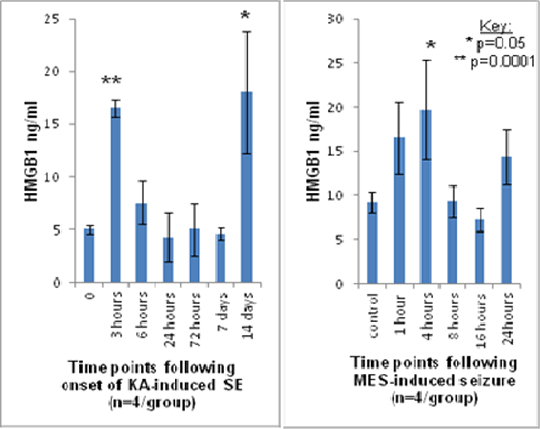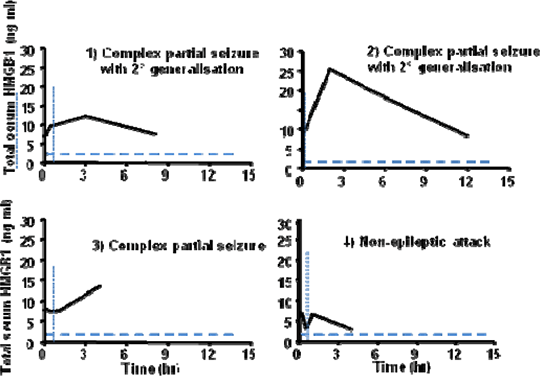Print version
Search Pub Med
HMGB1: A Novel Mechanistic Biomarker in Epilepsy
Brain inflammation has been described in both human epilepsy and experimental models of seizures. High Mobility Group Box-1 (HMGB1) is a “cellular alarmin”; alerting the immune system to sterile or infectious cellular insults. Through interaction with TLR4 it switches on the transcription of pro-inflammatory cytokine genes [1]. In rodent models of epilepsy, treatment of mice with Box A (antagonist fragment of HMGB1) or antagonists of TLR4 significantly reduce both the time spent in seizures and seizure severity [2]. The development of targeted immunomodulatory agents as antiepileptogenic strategies has tremendous potential, but this may come at a cost. Targeting a fundamentally protective pathway such as inflammation may have diverse and significant consequences. Careful patient selection is required to maximise the risk-benefit balance. HMGB1 has the potential to both stratify patients whilst providing insights into the mechanisms of drug-resistant epilepsy. 1) Epilepsy model: Adult male C57BL/6J mice (/~30g) were given repeated intraperitoneal injections of kainic acid until the onset of convulsive status epilepticus (SE), terminated by diazepam after 2 hours. Brain and blood was harvested 3, 6, 24, 72 hours, 7 and 14 days after SE. 2) Seizure model: Tonic seizures were induced in adult male CF1 mice (~25g) by supramaximal electrical stimulation delivered via corneal electrodes. Brain and blood was harvested 1, 4, 8, 16 and 24 hours after seizure. 3) Epilepsy Patients: Patients with chronic drug refractory epilepsy were admitted to the Walton Centre for Neurology & Neurosurgery for video EEG telemetry. Blood samples were taken 1, 4, 8 and 12 hours following seizure. Peripheral blood HMGB1 was significantly elevated 3-4 hours following seizures in rodent models and in an analogous pattern in humans with drug resistant epilepsy. Baseline HMGB1 in patients with drug-resistant epilepsy was significantly higher compared to controls (median 7.69 vs 0.74; p<0.0002).  
[1] Bianchi & Manfredi. Science 2009; 323: 1683-1684. [2] Maroso et al, Nat Med 2010; 16: 413-419.
|



 Future studies will determine whether HMGB1 levels at diagnosis can predict the development of drug resistance in a cohort of 200 newly diagnosed epilepsy patients.
Future studies will determine whether HMGB1 levels at diagnosis can predict the development of drug resistance in a cohort of 200 newly diagnosed epilepsy patients.